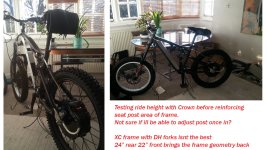richdeloup
100 W
Thanks for the boost
Here's my thinking that making the frame somewhat solid, wont actually add too much to the weight as cabling will take up at least 50% of the space, just need to fill the gaps and hope that it strengthens it somewhat.
Unlike resin, Alumilite is water thin when mixed and dried hard in around 3 minutes, so only get one shot at it but it can then be ground, drilled, sanded etc.
Here's my thinking that making the frame somewhat solid, wont actually add too much to the weight as cabling will take up at least 50% of the space, just need to fill the gaps and hope that it strengthens it somewhat.
Unlike resin, Alumilite is water thin when mixed and dried hard in around 3 minutes, so only get one shot at it but it can then be ground, drilled, sanded etc.







